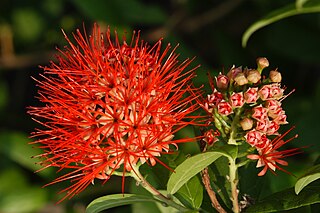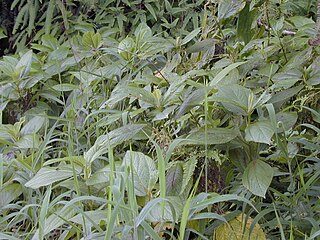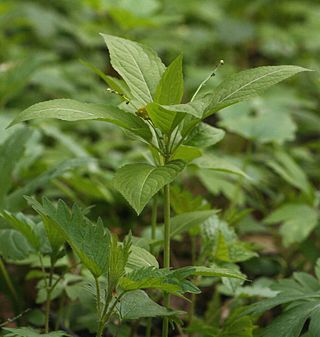
The Combretaceae, often called the white mangrove family, are a family of flowering plants in the order Myrtales. The family includes about 530 species of trees, shrubs, and lianas in ca 10 genera. The family includes the leadwood tree, Combretum imberbe. Three genera, Conocarpus, Laguncularia, and Lumnitzera, grow in mangrove habitats (mangals). The Combretaceae are widespread in the subtropics and tropics. Some members of this family produce useful construction timber, such as idigbo from Terminalia ivorensis. The commonly cultivated Quisqualis indica is now placed in the genus Combretum. Many plants in the former Quisqualis genus contain the excitotoxin quisqualic acid, a potent AMPA agonist.

Terminalia is a genus of large trees of the flowering plant family Combretaceae, comprising nearly 300 species distributed in tropical regions of the world. The genus name derives from the Latin word terminus, referring to the fact that the leaves appear at the very tips of the shoots.

Boehmeria is a genus of 47 species of flowering plants in the nettle family Urticaceae. Of the species, 33 are indigenous to the Old World and 14 to the New World; no species is indigenous to both the Old and New Worlds. The species include herbaceous perennials, shrubs and small trees. Although related to the similar-looking species of the stinging nettles of genus Urtica, species of Boehmeria do not have stinging hairs. Because of the similarity in appearance, some species are commonly called "false nettles".

Indigofera is a large genus of over 750 species of flowering plants belonging to the pea family Fabaceae. They are widely distributed throughout the tropical and subtropical regions of the world.

Mercurialis is a genus of plants in the family Euphorbiaceae, the spurges, known commonly as the mercuries. These are slender herbs (forbs), rhizomatious perennials and woody perennials, native to Europe, North Africa, and Asia.
- Mercurialis annuaL. – most of Europe, North Africa, the Middle East, and islands of the eastern Atlantic
- Mercurialis canariensisObbard & S.A.Harris – Canary Islands
- Mercurialis corsicaCoss. & Kralik – Corsica, Sardinia
- Mercurialis ellipticaLam. – Spain, Portugal, Morocco
- Mercurialis huetiiHanry – Spain, France, Morocco
- Mercurialis leiocarpaSiebold & Zucc. – China, Japan, Korea, Ryukyu Islands, Thailand, Assam, Bhutan, Nepal
- Mercurialis × longifoliaLam. – Spain, Portugal, France (M. annua × M. tomentosa)
- Mercurialis ovataSternb. & Hoppe – C + E Europe and SW Asia from Germany + Italy to Russia + Syria
- Mercurialis × paxiiGraebn. – C + E Europe from Germany to Crimea (M. ovata × M. perennis)
- Mercurialis perennisL. – most of Europe plus Algeria, Caucasus, Turkey, Iran
- Mercurialis reverchoniiRouy – Spain, Morocco
- Mercurialis tomentosaL. – Spain, Portugal, France, Balearic Islands

Anogeissus is a genus of trees in the family Combretaceae. The 10 to 12 species are distributed in Asia and tropical Africa. Plants of the World Online now refers to this genus as a synonym of TerminaliaL.

Bruguiera is a plant genus in the family Rhizophoraceae. It is a small genus of five mangrove species and three hybrids of the Indian and west Pacific Ocean region, its range extending from East Africa and Madagascar through coastal India, Sri Lanka and Southeast Asia to northern Australia, Melanesia and Polynesia. It is characterised by calyces with 8-16 lanceolate, pointed lobes, 16-32 stamens, explosive release of pollen, and viviparous propagules. It is named in honour of French explorer and biologist Jean Guillaume Bruguière (1750–1798). Recently, the eighth taxa of Bruguiera, B. × dungarra was recognised as occurring in northern Australia.








